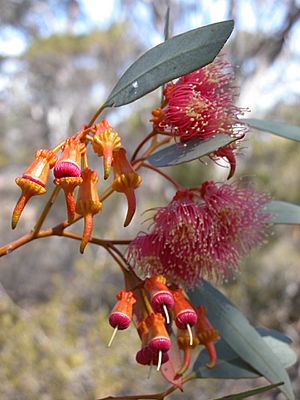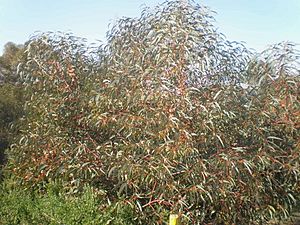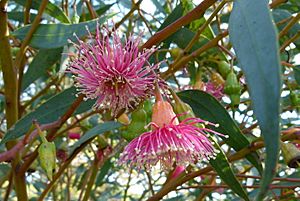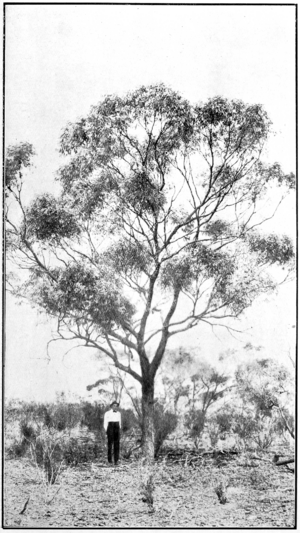Coral gum facts for kids
Quick facts for kids Coral gum |
|
|---|---|
 |
|
| Scientific classification | |
| Genus: |
Eucalyptus
|
| Species: |
torquata
|
The Coral Gum, also known as the Coolgardie Gum, is a special tree found only in Western Australia. People often plant this tree in gardens and along streets because it's so beautiful.
Contents
What Does the Coral Gum Look Like?
The Coral Gum is a small, strong tree with really pretty flowers. It usually grows to be about 4 to 11 meters (13 to 36 feet) tall. It has a wide, spreading shape.
Flowers and Buds
This tree produces clusters of orange, barrel-shaped buds. These buds have unique "horned" caps. Later, these buds open into many bright red or pink flowers. You can usually see these flowers between August and December. Sometimes, you might even spot white, cream, or red flowers!
Bark and Leaves
The bark of the Coral Gum is rough and stays on the trunk and branches. It looks like a fibrous, flaky box-type bark, often grey-black, grey, or black with whitish patches.
The leaves are a greyish-green color. They are shaped like a spearhead, about 90 to 120 mm (3.5 to 4.7 inches) long and 15 to 20 mm (0.6 to 0.8 inches) wide.
How Was the Coral Gum Named?
The Coral Gum was first officially described by a botanist named Johann George Luehmann in 1897. He wrote about it in a publication called Victorian Naturalist. The first sample of the tree was collected near Coolgardie, Western Australia.
The scientific name, torquata, comes from a Latin word meaning "having a twisted ring or collar." This name refers to the cool, twisted shape you can see at the base of the buds and fruits.
People also call this tree the "Christmas tree" because its flowers often appear in December, around Christmas time. Another common name is "Goldfields red flowering gum," which refers to the Goldfields region where it grows and its red flowers.
Where Does the Coral Gum Grow?
You can find the Coral Gum growing on hillsides around places like Kalgoorlie and Coolgardie in the Goldfields region of Western Australia. It likes to grow in stony loam, clay, or red sandy soils.
Why Do People Use Coral Gum?
The Coral Gum is a popular choice for planting in small gardens. It's also used as a decorative tree or a street tree, especially in dry areas. What's cool is that it can start flowering just two years after being grown from a seed! You can even grow it in large pots if the soil drains well.




